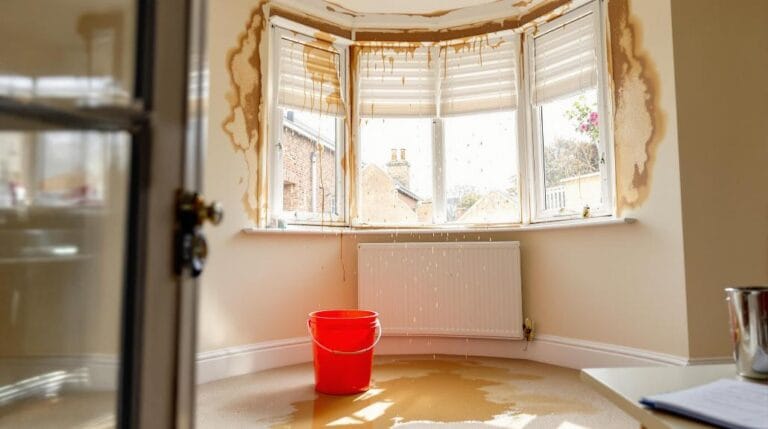A home insurance claim in the UK is a formal request for compensation when your property suffers damage or loss that is covered by your policy. The process typically begins within 48 hours of an incident and requires detailed documentation including photographs, receipts, and evidence of damage.
Common claims involve water damage, fires, storms, and theft, with insurers paying out around £15 million daily for household claims. Understanding the correct steps and documentation can make the difference between approval and rejection.
Understanding Home Insurance Claims in the UK
Making a home insurance claim can feel daunting, especially when you’re already dealing with property damage. Whether it’s a burst pipe, storm damage, or the aftermath of a break-in, understanding what constitutes a home insurance claim in the UK is crucial for every homeowner. With British insurers paying out an impressive £15 million daily for household claims, it’s essential to know exactly what a claim is and how to handle one effectively.
Key Takeaways
- A home insurance claim is a formal request to your insurer for compensation when your property or belongings suffer damage or loss.
- Claims must typically be reported within 48 hours of the incident and formally filed within 180 days in the UK.
- UK insurers pay approximately £15 million daily for household claims.
- Documentation including photographs, videos, receipts, and detailed lists of damaged items is essential for UK home insurance claims.
- Professional loss adjusters assess significant claims through site inspections and determine coverage based on policy terms.
Common Types of Home Insurance Claims
British homeowners encounter several common types of property losses that can lead to insurance claims.
Water damage from burst pipes is the most frequent, while fire damage, although less prevalent, often results in the most severe financial implications. Homeowners should also be aware that accidental damage coverage ranks among the top three most common insurance claims.
There has also been a notable increase in storm-related claims in recent years, with average payouts reaching £1,200 for water damage and significantly more for extensive structural repairs following severe weather events.
Most Frequent Property Losses
Property damage can occur when homeowners least expect it, leading to some of the most common insurance claims in the UK.
The most frequent claims involve the escape of water from burst pipes and faulty appliances, accounting for up to 29% of all property damage cases.
Weather-related incidents follow closely behind, with storm damage from high winds and heavy rain making up about 13% of claims.
Meanwhile, accidental damage from DIY mishaps and everyday accidents represents nearly one-fifth of all cases.
Theft remains a significant concern, particularly in London boroughs where claim rates are highest.
Regional patterns show interesting variations, with Jersey experiencing more storm claims and Watford reporting higher instances of water damage.
These patterns assist insurers in understanding where specific types of coverage are most needed.
Fire-related incidents are also significant contributors to property claims, with insurers paying out £1.3 billion annually for fire damage claims.
Learn more: Review the most frequent types of home insurance claims – See which incidents lead to claims in the UK.
Financial Impact By Type
Insurance payouts reveal the true financial toll of home disasters across the UK. Understanding claim statistics helps homeowners prepare for potential losses and make informed decisions about their coverage.
The financial implications vary significantly by incident type. While accidental damage claims average £615, water-related incidents command higher payouts at £1,200. Theft and flood damage typically result in £1,500 settlements, while storm damage averages £1,000.
These figures translate into substantial daily expenditure for insurers, who pay out £15 million for household claims. Escape of water incidents alone account for £1.8 million in daily payments. Premium holders should note that two UK insurers maintain a near-perfect 99% acceptance rate for claims.
The industry maintains an impressive 82% claim acceptance rate, demonstrating reliability when homeowners need support most.
Regional variations and specific incident types influence payout amounts, making it essential to understand local risk factors.
Essential Steps in the Claims Process
When disaster strikes your home, taking immediate action and properly documenting the damage can make the difference between a smooth or difficult claims process.
A thorough record of the incident should include clear photographs from multiple angles, detailed notes about what occurred, and receipts for any emergency repairs needed to prevent further damage. Working with qualified Loss Assessors during property assessment ensures accurate evaluation of damages and appropriate compensation.
The key to success lies in acting swiftly while maintaining careful attention to detail – from notifying your insurer within the required timeframe to creating a comprehensive inventory of affected items.
Learn more: Understand the UK claims process step-by-step – Find out what happens after you submit your claim.
Documenting Damage and Loss
Filing a successful home insurance claim begins with thorough documentation of damage and loss. Gathering photographic evidence from multiple angles serves as a vital foundation for your claim.
Creating a detailed itemised list helps establish the full extent of damages while supporting documentation builds a stronger case.
When documenting damage, remember these essential elements:
- Take clear photos and videos of all affected areas
- Keep receipts for emergency repairs or replacements
- Record serial numbers of damaged electronics
- Save all communication with insurers and contractors
Supporting evidence may also include bank statements, valuations, and maintenance records.
For claims involving theft or vandalism, obtaining a crime reference number and CCTV footage can prove indispensable.
Remember not to dispose of damaged items until the insurer has completed their assessment.
Most insurance providers give homeowners up to 180 days to submit their claim with all necessary documentation.
Quick Emergency Response Actions
A quick emergency response can make the difference between a manageable claim and a costly disaster. When faced with property damage, residents must first ensure their safety and prevent further issues. This includes securing the property and contacting emergency services if necessary.
The next vital step involves notifying the insurance company promptly. Most UK insurers require notification within 48 hours of the incident. During this time, a thorough assessment of the damage should be conducted to document all affected areas. In cases of theft or vandalism, homeowners must file a police report immediately.
While waiting for a professional assessment, homeowners can make temporary repairs to prevent additional damage. Taking photos and videos before these repairs is essential for the claims process.
Remember to keep all receipts for emergency work – these costs are often recoverable through the insurance claim.
Discover how to avoid delays in your claim process – Learn strategies to report and document incidents promptly.
Documenting Your Claim Effectively
The success of any home insurance claim heavily relies on thorough documentation and evidence. Proper claim timelines and evidence preservation can significantly influence the outcome, determining whether a claim is approved or rejected.
Understanding how to document effectively ensures a smoother claims process.
Essential documentation includes:
- Photographs from multiple angles showing all damage
- Videos providing additional context and perspective
- Detailed lists of affected items and areas
- Relevant receipts, invoices, and policy documents
Creating a digital archive of evidence helps keep everything organised and easily accessible. Remember to store physical copies in a secure location as a backup.
When documenting damage, act promptly and be thorough. Do not dispose of or alter damaged items until your insurer has assessed them. Regular communication with your insurer helps maintain transparency throughout the claims process. Most insurers give you 180 days to submit your claim documentation.
Get top tips for speeding up your claim – Discover practical advice to fast-track your process.
The Role of Loss Adjusters
While thorough documentation builds the foundation of a claim, professional assessment often determines its outcome. Insurance companies frequently appoint Loss Adjusters for significant or complex claims to provide an impartial evaluation of the situation.
Loss Adjuster responsibilities encompass a wide range of vital tasks. They perform detailed site inspections, assess the extent of damage, and ascertain whether the loss is covered under your policy terms.
These professionals gather evidence through photographs and documentation while evaluating any efforts you’ve made to prevent further damage. They carefully review repair and replacement estimates to determine appropriate restoration costs.
Although employed by insurance companies, Loss Adjusters maintain professional independence in their assessments. They will communicate directly with you, request necessary documents, and compile extensive reports that influence the final settlement.
Think of them as independent investigators working to establish the facts of your claim.
Related: Explore common reasons for claim rejections – Get insights into why claims are sometimes denied.
Making Emergency Repairs During Claims
Facing extensive property damage often prompts homeowners to take immediate action. Following emergency repair guidelines ensures both safety and proper claims processing. Most insurers understand the necessity for temporary repair solutions to prevent further damage while waiting for assessment. Authorised repairers aim to arrive within four hours of emergency notification.
Key steps for emergency repairs include:
- Document all damage with photographs before making repairs
- Keep receipts for materials and emergency services
- Make only essential temporary fixes
- Contact the insurer before undertaking major repairs
Remember that emergency repairs should focus on preventing additional damage rather than providing permanent solutions.
Most policies cover these temporary measures up to specified limits—typically between £500 and £1,000. Just ensure all work is properly documented and approved by your insurer to avoid complications with your claim later.
Key Exclusions and Policy Limitations
Understanding key exclusions and limitations in home insurance policies helps homeowners avoid costly surprises during claims. Common exclusion examples include wear and tear from ageing, pre-existing damage, and extended periods when homes are left unoccupied.
Policy limitations often restrict coverage for business-related damages and high-value items like jewellery or artwork. Many standard policies won’t cover accidental damage unless additional coverage is purchased. Have you checked if your policy covers detached structures like garages?
Specific circumstances can also void coverage. Pet damage, frost issues, and renovation-related problems typically require specialised insurance. Damage caused by family members and poor maintenance is usually excluded too.
Keep in mind that all claims are subject to policy excess – the amount you’ll need to pay before insurance kicks in.
Best Practices for Claims Success
Successful home insurance claims begin with smart preparation and attention to detail. Effective claims preparation involves maintaining thorough documentation and understanding your policy coverage before incidents occur.
To maximise your chances of a successful claim, consider these essential steps:
- Document your possessions with photographs and receipts
- Keep detailed maintenance records of your property
- Store policy documents and emergency contacts in an accessible location
- Create a home inventory with values and descriptions
Effective communication with your insurer is vital throughout the claims process. When incidents occur, report them promptly and maintain clear records of all interactions.
Taking photographs of damage before temporary repairs and keeping receipts for any emergency work will strengthen your position during the settlement process.
Wrapping Up
Understanding home insurance claims doesn’t have to be complicated. As a UK homeowner, knowing that a claim is simply your formal request for compensation when covered damage occurs can help demystify the process. Remember, prompt action within 48 hours, thorough documentation, and clear evidence are your keys to a successful claim. Whether you’re facing water damage, fire, storm damage, or theft, being prepared with this knowledge could make all the difference when you need to protect your most valuable asset – your home.
Worried About Making a Home Insurance Claim in Northern Ireland?
Understanding insurance claims is one thing – but managing them properly is another. At PCLA, our claims management team will handle the entire claims process for Northern Ireland homeowners, ensuring nothing is overlooked.
For practical support with your claim ring our Belfast office on 028 9581 5318 for a straightforward chat about your claim.



